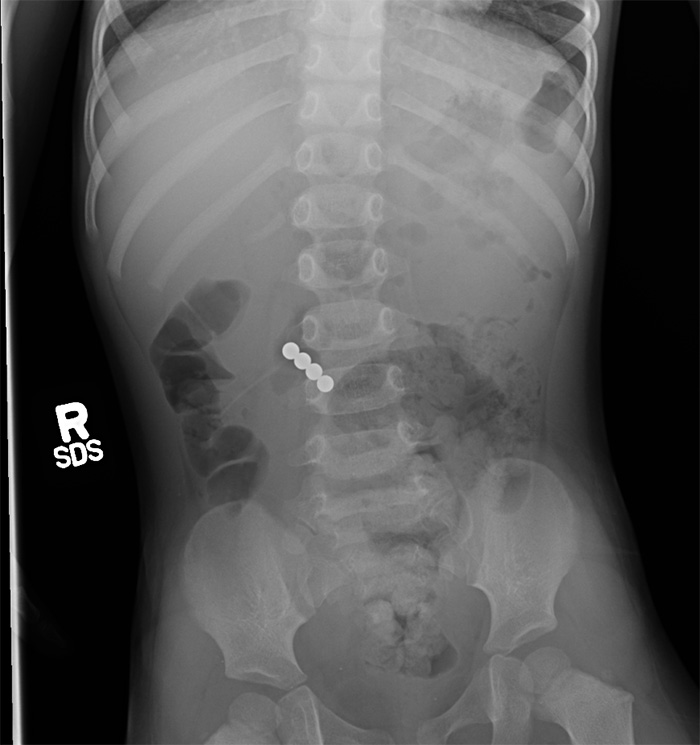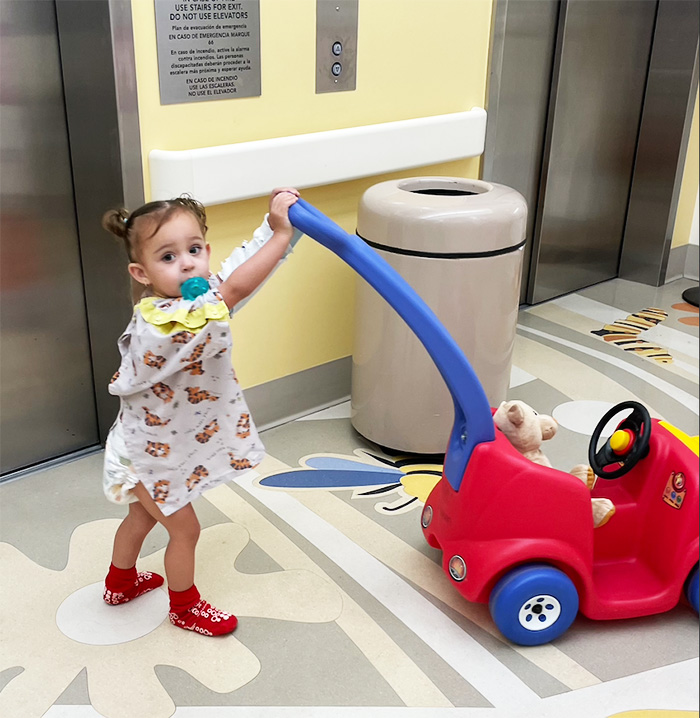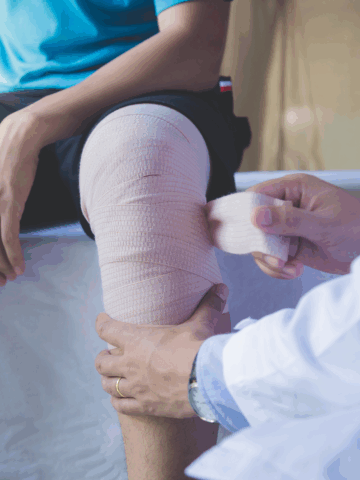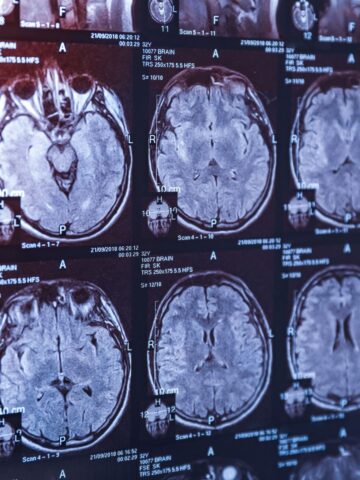The toddler awoke at 3:30 a.m. with stomach pain.
Soon, 2-year-old Luna Mangels was vomiting.
Weird, thought her parents, Philip and Patricia.
They racked their brains: What did she eat last night?
Then they remembered: Their son, Gabriel, 12, had seen Luna playing with his set of tiny, strong magnets just before bedtime. The silver magnetic balls – each the size of a BB pellet – can be molded into different shapes.
“Did you put any of these in your mouth?” Gabriel asked his baby sister.
At a phase when she’s answering “yes” to most questions, Luna responded in the affirmative.
But her parents didn’t worry too much before they slept, thinking if she had, in fact, swallowed one, the tiny magnet likely would pass with no issues.
What transpired next was a terrifying journey for the Mangels and their son and a very painful experience for Luna.
The toddler’s emergency room visit to CHOC prompted pediatric surgeon Dr. Laura Goodman to fire off a message to the U.S. Consumer Product Safety Commission (CPSC) about what has long been regarded as among the most dangerous ingestion hazards in children – but what remains readily available for purchase online and in gift stores.
Magnets as a documented hazard for children
Small, high-powered magnet sets showed up as children’s toys in the early 2000s and then later in 2009 as desk toys for office workers to relieve stress and boredom.

Ten times stronger than common household refrigerator magnets, their size and attractiveness (when multicolored, they look like candy) make them a huge hazard for wee ones.
When more than one of these magnets is swallowed, they attract to each other across tissue, cutting off blood supply to the bowel and causing obstructions, tissue necrosis, perforation, sepsis, and even death.
Ingestion of these magnets led to 1,700 hospital visits in the U.S. from 2009-2011, according to the CPSC. Most patients were children. Some required surgery to remove the magnets. A few had permanent damage to the digestive tract. At least one child died, according to the CPSC.
Emergency surgery for magnet removal
Luna played with the magnets on the evening of May 10, 2022. It wasn’t the first time she had done so. Her brother had had them for about five years.
After Luna repeatedly vomited the next morning, the Mangels called their doctor. He told them to go to urgent care for an X-ray. It showed Luna had swallowed four magnets.
They likely will pass but to be safe go to CHOC, the physician told the Mangels.

They did, and Dr. Goodman, who joined CHOC last September, saw Luna in the ED.
During her fellowship at Loma Linda University Medical Center, Dr. Goodman had seen a couple of magnet cases. One patient had a bowel obstruction and another suffered a tissue perforation caused by two magnets stuck together.
The X-ray of Luna showed the four magnets together, but there was no way to tell if they were in one loop of the intestine, or endangering Luna by sticking together across two different parts of the intestine.
Dr. Goodman recommended surgical removal.
“We were freaked out,” Philip recalls. “Knowing your 2-year-old has to have surgery isn’t the easiest thing to go through.”
Four days in hospital
Dr. Goodman believed the magnets inside Luna were threatening to perforate tissue. As she explains, “because of her degree of pain, I thought they were doing something bad in there, so I decided to operate.”
Surgery on Luna began at around 9 p.m. on May 11.
“With a small laparoscopic incision, I was able to find the magnets, but in order to pull them out I had to make a small exploratory laparotomy through her belly button, cut open her intestine, and take them out,” Dr. Goodman says, adding of Luna avoiding serious injury: “It was definitely a near miss.”
Although one magnet had safely passed to Luna’s rectum, three were in her small intestine and colon. The magnets were stuck across the walls of the different loops of intestines, and if untreated, would have perforated.

The procedure took only 90 minutes, but Luna remained at CHOC for four days. She had to have a gastric tube in for a few days after surgery and had to wear arm restraints so she wouldn’t fiddle with the bandages on her belly.
It took a couple of days for her to be able to consume liquids.
“It was very traumatic for the family to see her going through all of this,” Dr. Goodman says.
Today, Luna is doing fine.
A harrowing experience
Philip says Luna’s medical emergency was harrowing for him, his wife, and his son. But Dr. Goodman and others on her team made things a little easier.
“They were extremely calm and understanding of the situation, and made us feel more comfortable,” Philip says.

Three pastors and members of the Mangels’ Bible study group at Mariners Church came to pray for Luna, and that helped a lot, Philip says.
Dr. Goodman hopes her report to the CPSC helps lead to more restrictions on high-powered magnets sold as toys or adult diversions.
Restrictions lifted by Consumer Product Safety Commission
In 2012, the CPSC passed a regulation that effectively banned small rare-earth magnet sets – so named because they’re mainly made of neodymium, iron, and boron. But the restrictions were lifted in 2016 following a court challenge.
Voluntary safety warnings by magnet manufacturers did nothing to prevent children, or anyone, from swallowing the magnets, critics said, and the numbers support this.
After the restrictions ended in 2016, calls to poison centers about high-powered magnets increased by 444%, according to a March 15, 2021, report by Nationwide Children’s Hospital in Columbus, Ohio. There was also a 355% increase in the number of cases that were serious enough to require treatment in a hospital.
Such findings reflect the urgent need to protect children through preventive efforts and government action, the report concluded.
More restrictions from CPSC for magnets on way?
Recently, progress has been made.
As reported in the Washington Post on Aug. 17, 2021, the CPSC announced a rare mandatory recall for two brands of high-powered magnet sets – Zen Magnets and Neoballs. The CPSC is working on regulations that would effectively ban all magnet sets, the Post reported.
But Dr. Goodman still worries about seeing another patient like Luna.
“These magnets are so non-essential,” she says. “It’s not like they’re holding cars together – they’re just for desk decorations, and they’re hurting kids. I feel they are an unrecognized danger out there. It’s a ridiculous situation.”
Tips for parents to prevent injury from magnets
Swallowing magnets is a serious, life-threatening matter, says Poison Control.
Prevention is key.
Children often don’t report what they did. Signs and symptoms of swallowing magnets can often be mistaken for a viral illness. They may include nausea, vomiting, abdominal pain, and fever.
Here are some tips to avoid accidental ingestion:
- If magnets are used in the home, store them in a locked cabinet or box out of reach of children and pets. Be sure to discard them safely, too.
- Magnet sets should also be kept away from older children and individuals with developmental delays or the elderly with memory impairment. Older children can play with them in their mouths, commonly trying to see if they can separate them with their teeth, leading to accidental swallowing.
- Choose refrigerator magnets that are large enough that they cannot be swallowed or pose a choking hazard to children.
- Avoid the use of magnetic beads as fake body piercings.
- After use of magnets, count each piece to make sure none are missing.
If anyone swallows a magnet, here’s what you should do:
- Do not try to make the person throw up.
- Do not give anything to drink or eat.
- Call Poison Control right away at 1-800-222-1222. The experts will tell you what to do.

CHOC Hospital was named one of the nation’s best children’s hospitals in seven specialties by U.S. News & World Report in its 2025-26 Best Children’s Hospitals rankings.




